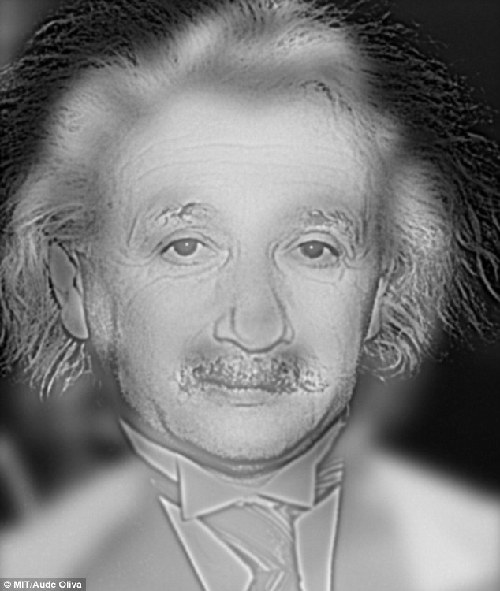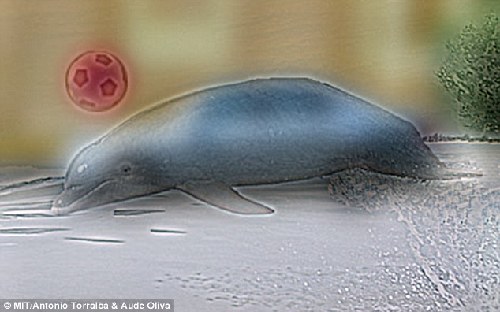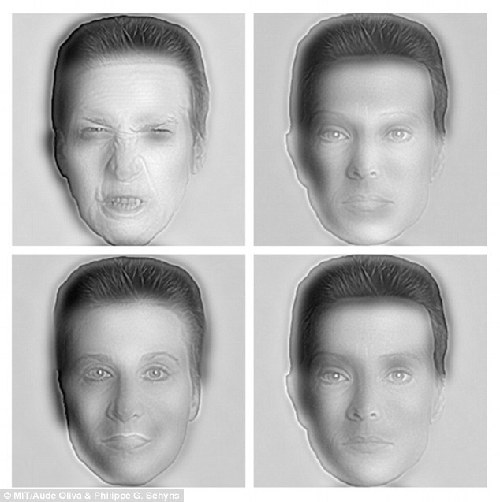當前位置: Language Tips> 雙語新聞
Who do YOU see: Albert or Marilyn? Optical illusion could reveal if you need glasses
分享到
As this image gets larger, what do you see?
隨著這張圖片越放越大,你看到了誰?

Most people will pick out a phantom-like picture of Albert Einstein. But if you see a Hollywood pin-up, you may need a trip to the opticians.
大多數人看到的是阿爾伯特·愛因斯坦的一張詭異照片。如果你看到的是好萊塢女明星,也許你就得去一趟眼鏡店了。
At normal viewing distance, healthy eyes should be able to pick up the fine lines on Einstein's face, causing the brain to disregard Marilyn Monroe's image altogether.
在正常的觀察距離下,健康的眼睛能夠捕捉到愛因斯坦臉上的線條,這讓大腦可以完全忽略瑪麗蓮·夢露的圖像。
This classic optical illusion was created several years ago by neuroscientists at the Massachusetts Institute of Technology.
這一視錯覺經典圖像是麻省理工學院神經系統科學家們幾年前制作的。
In a recent video, Asap Science highlighted the process behind the trick, which can also be seen in a still image by anyone if they move closer and then farther away from the screen.
在最近的視頻中,YouTube科普大神Asap Science揭露了這個視錯覺背后的操作過程,只要觀察者調整自己與屏幕的距離,那么每個人都能從一幅靜態圖片中觀察到圖片的變化。
‘Depending on how well you're able to focus or pick up contrast, your eye will only pick out details,’ the video explains. 視頻中這樣解釋道:“這都取決于你的聚焦能力和識別對比度的能力,你的眼睛只會關注細節。”
‘Up close, we're generally able to pick up fine details like Einstein's moustache and wrinkles.
“近距離觀察時,我們大都能夠觀察到圖片上的細節,比如愛因斯坦臉上的小胡子和皺紋。
‘But as the distance increases, or if your vision is poor and creates a more blurred image in the first place, your ability to pick up details fades away.
“但當觀察距離被拉長,或是視力問題讓你看到的圖像變得模糊時,你觀察事物細節的能力就會逐漸消失。
‘Instead you only see general features, like the shape of mouth, nose and hair, and are left seeing Marilyn Monroe. ‘
“這時,我們只能看到大致的容貌特征,比如嘴型、鼻子和發型,因此,我們最終會看到是瑪麗蓮·夢露的畫像。”
The MIT team, led by Dr Aude Oliva, has spent over a decade creating hybrid optical illusions that show how images can be hidden with textures, words and other objects.
由奧德·奧利瓦博士領銜的麻省理工團隊經過十年的努力,最終制作出了這些混合視錯覺圖像,向我們展示了圖像是怎樣被紋理、文字和其他圖案隱藏起來的。
'Marilyn Einstein' was created by superimposing a blurry picture of Marilyn Monroe over a picture of Albert Einstein drawn in fine lines.
這張“瑪麗蓮·愛因斯坦”混合圖像由夢露的模糊照片疊加在愛因斯坦的細線素描上組成。
Features with a high spatial frequency are only visible when viewing them close up, and those with low spatial frequencies are only visible at a distance.
高空間頻率的容貌特征只有在近距離的情況下才能看出,而那些低空間頻率的圖像特征只能在遠距離的情況下可見。
Combining pictures of the two produces a single image which changes when the viewer moves closer or farther away from the screen.
當我們把這兩種圖像疊加在一起時,觀察者可以通過調整自己與屏幕的距離,而看到不同的圖像。
Dr Oliva's group say these images not only reveal vision problems, but can also highlight how the brain processes information.
奧利瓦博士的團隊稱,這類圖片不僅能暴露視力問題,還顯示了我們的大腦是如何處理信息的。
In one study, participants were shown hybrid images for just of 30 milliseconds, and only recognised the low spatial resolution, or blurry, component of the image.
在一項研究中,當參與者只有30毫秒觀察混合圖像時,他們只能看到低空間分辨率的,或是模糊的局部圖像內容。


But when the images were shown for 150 milliseconds, they only recognised the image that was produced in fine detail, or in high spatial resolution.
但當圖片顯示150毫秒時,他們只能分辨出用細線畫出的圖像,或是高空間分辨率的圖像。
In a separate test, they were shown sad faces in high spatial resolution and angry faces in low spatial resolution. They superimposed pictures used both male and female faces.
在另一項測試中,研究人員們向他們展示了一張高空間分辨率的悲傷面容,和一張低空間分辨率的憤怒面容。這些圖像通過疊加男性和女性的面容制作而成。
When displayed for 50 milliseconds, participants always saw an angry face, but were unable to pinpoint the sex of the person pictured.
當圖片只顯示50毫秒時,參與者看到都是一張帶有憤怒表情的圖像,但卻不能精準地描述出圖中人物的性別。
Dr Oliva says this shows that our brains discriminate between picking out fine detail in some situations, and broader detail in others.
奧利瓦博士表示,這證明在特定情況下,我們大腦能夠區分圖片中細小的細節和更為廣泛的細節。
The brain's processing of fine details happens slightly later than processing other features, according to the research.
研究表明,大腦處理細節信息的過程要比處理其他樣貌特征的過程略微緩慢些。
The teams believe hybrid images such as this may prove useful to advertisers who want to change how their logos appear at different distances.
研究團隊認為,如果廣告商想讓商標在不同觀察距離下呈現出不同的影像,類似這樣的混合圖像會很有利用價值。
It could also be used to mask text on devices so only someone viewing close up can read it. 同時,我們還可以用這種技術來掩飾儀器上的文本信息,只有當人們近距離查看時才能看到其中的內容。

Vocabulary
pin-up: 女明星
optical illusion: 視錯覺
superimpose: 使(圖像)疊加
(翻譯:張展文BISTU 編輯:Helen)
上一篇 : 英少年視伊斯蘭國為流行偶像
下一篇 : 出游貼士:盤點各國奇葩法律
分享到
關注和訂閱


電話:8610-84883645
傳真:8610-84883500
Email: languagetips@chinadaily.com.cn